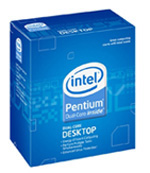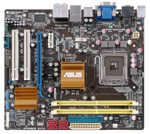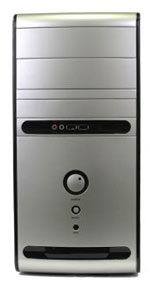Intel Entry-level PC
Intel still owns the pole position in CPU performance, but the area from entry to upper midrange is very competitive between Intel and AMD. In fact, as pointed out in the recent Phenom II Buyers' Guide, AMD is often the better value in the broad midrange category. The only area still dominated by Intel is the very top, where CPUs cost $280 and more.
The one advantage that remains for Intel is that their processors generally overclock better than current AMD CPUs. That has changed with Phenom II in the midrange, but most of today's entry AMD processors still use older designs that do not overclock as well as Intel choices. Overclocking is not normally a consideration in entry computers, but it could be for some buyers, and at the lowest rungs of the CPU ladder Intel processors remain the best overclockers for now.
| Intel Entry-level PC | ||
| Hardware | Component | Price |
| Processor | Intel Pentium Dual-Core E5200 Wolfdale (Dual-core 2.5GHz, 45nm, 65W, 2MB shared L2, 800FSB) | $70 |
| Cooling | CPU Retail HSF | - |
| Video | On-Board | - |
| Motherboard | ASUS P5QL-CM G43 HMDI uATX | $80 |
| Memory | Patriot Viper Model PVS24G6400LLK 4GB DDR2-800 4-4-4 ($52 less $25 Rebate) | $27 |
| Hard Drive | WD Caviar GP WD5000AACS 500GB | $55 |
| Optical Drive | Sony Optiarc Model AD-7240S-OB 24X DVDRW SATA | $24 |
| Audio | On-Board | - |
| Case | SIGMA La Vie LBYWBP Leather Mid-Tower w/ 500W PSU ($65 less $20 Rebate) | $45 |
| Power Supply | 500W Included with Case | - |
| Base System Total | $301 | |
| Display | Acer X193W+BD 19" 5ms Widescreen LCD (1680x1050) | $110 |
| Speakers | Cyber Acoustics CA3090WB 2.1 Gaming Speakers | $16 |
| Input | Microsoft CA9-00001 PS/2 Keyboard and Optical Mouse | $17 |
| Operating System | Microsoft Vista Home Premium SP1 (for System Builders) | $99 |
| Complete System Bottom Line | $543 | |
 |
Our choice for the Intel entry CPU remains the excellent 2.5GHz dual-core E5200 Wolfdale. This 65W rated CPU is built on Intel's 45nm manufacturing that begs you to overclock. The E5200 uses a default 800FSB, so right out of the box the first option for overclocking, if you are so inclined, is to bump it up to 1066 bus. That will give you a 33% overclock and a final speed of 3.33GHz, and it is readily attainable with proper cooling. Even if you never overclock you will be very pleased with the performance of the E5200.
The E5200 is an easier choice now that the price has dropped from $83 a few months ago to $70 today. We do not recommend going lower than an E5200 in an Intel system because the trade-offs in performance for the few dollars saved are too great. The performance of the E1200 at $50, for example, is dismal compared to the E5200, and certainly not a good choice in performance for the $20 saved. The only drawback to this processor choice is the lack of Intel's Virtualization Technology (Intel VT). If running the Windows Virtual PC under Windows 7 for XP Mode (as one example) is important to you, then moving up to the E8x00 range or down to the E6x00 allow the best VT options in this range, although this budget point is no longer valid.
Unlike the numerous AMD product choices in the $60~$80 price range that feature current chipsets and loads of features, the Intel selections are mostly limited to older chipsets like the G31 or NVIDIA GeForce 7100 series. These chipsets are stable, well supported, and are valid options for basic entry-level systems. Intel is promoting the G41 chipset into this price range now and we seriously considered a couple of very good G41 boards, but they featured VGA output or the storage options were limited due to the ICH7 for the type of system we had in mind. Fortunately, ASUS came through with some timely price reductions on their G43 based ASUS P5QPL-CM motherboard and it was an easy decision to choose this particular board for our budget based system.
 |
The P5QL-CM features the latest G43 GMCH along with the ICH10 Southbridge. The GMA X4500 graphics engine does not feature the hardware accelerated H.264/VC-1/MPEG2 decoding capability of the G45 or NVIDIA GeForce 9300 chipsets, but HD video playback is acceptable with a decent processor like the E5200. Otherwise, the performance of the G43 is fine for SOHO applications, flash-based games, and general video duties. However, insert a discrete video card like the HD 4770 and any weaknesses of the G43 chipset go away in an instant.
The P5QL-CM features support for the latest Core 2 Duo, Core 2 Quad, and Pentium/Celeron dual-core processors along with 8GB memory support. The board has a very good layout with one PCIe x16 slot, one PCIe x1 slot, and two PCI slots. The ICH10 does not support RAID but does provide six SATA 3Gb/s ports, one IDE port, and twelve USB 2.0 ports. ASUS includes the 8-channel VT1708B HD audio codec, Realtek RTL8111B Gigabit LAN, and DisplayPort, DVI-D, and VGA video out ports. ASUS based this motherboard on the uATX form factor and it includes a basic accessory kit along with several ASUS specific software applications. The board has proven to be very stable and problem free over the last 30 days. It is not an overclocking demon with our E5200/E7200 being limited to the 345FSB range due to the chipset, but that is more than enough headroom (4.16GHz with the E5200) for most users.
 |
The case and power supply choice are the same Sigma La Vie 500W Mid Tower chosen for the AMD entry system. At a final price of $45 for this good-looking, side-window case and Sigma 500W power supply it is a value that is hard to pass up. If you prefer a smaller Micro ATX case, the HEC 6K28BSOH48D mini tower is a good alternative. HEC is best known as a manufacturer of power supplies. Some are sold under their own name, but most are manufactured for other well known power supply brands. HEC includes a 485W PSU with this attractive mini tower, which should provide plenty of power for your entry build.
Other components are the same ones chosen for the AMD Entry system. Some readers will also notice that our link for the Windows Vista Home Premium System Builders OS is for the 64-bit version. Whether you choose 64-bit or 32-bit, the price of Vista is the same. The choice is yours, but you will need the 64-bit version to fully use the 4GB or more system memory. While 64-bit has made giant strides in drive and component compatibility, if you have an old printer or other peripherals you want to bring from Windows XP to Vista you need to check compatibility very carefully. 32-bit Vista generally works with almost anything that worked with Windows XP, but that is not always true of 64-bit. If you are starting fresh, we recommend choosing 64-bit Vista.
If we compare the two entry-level systems, the winner depends on what is of more value to you. The Intel system is a bit more powerful, but you can move up to a high-end Athlon X2 or a low-end AMD Phenom II X3 for comparable performance at less than $85. If you are an overclocker, the Intel entry may be your best choice. For a gamer, the AMD offers more flexibility for future expansion. For the typical entry-level PC right now and for what the system typically is used for - internet, office, low-end gaming, and low to mid graphics - you can go either route and be very happy.










65 Comments
View All Comments
bupkus - Tuesday, May 19, 2009 - link
Could you list a Crossfire motherboard option for those who think of a budget system as one that would allow a second HD4770 for future upgrade?Gary Key - Wednesday, May 20, 2009 - link
Hi,Unlike the AMD side, there are not any standout CF boards that fit within our budget guidelines for this article. That said, I like the DFI BI P45-T2RS at $107, ASRock P45XE at $90, Biostar TForce TP45HP at $100, and my favorite P45 board, the Gigabyte GA-EP45-UD3P at $130 but $110 with a rebate right now.
With the last BIOS update, the DFI LP JR P45-T2RS at $110 is an interesting choice as it is an uATX format and works well in a SFF system, especially with two HD4770 cards. I have not tested the ECS BS P45T-A, but it seems to have positive comments around the forums (looking at price compared to performance/quality) for $82 with the MIR.
Wesley Fink - Tuesday, May 19, 2009 - link
For an AMD CPU there are lots of good Crossfire X motherboard choices. One geed choice is the Asus M4A78 Plus which sells for just $79 so it still fits the budget very well.Choosing an Intel board with dual PCIe x16 slots is a lot more difficult. I have asked Gary Key, our Motherboard Editor, to comment on an Intel choice.
PC Reviewer - Monday, May 18, 2009 - link
id change the video card to an hd 4890 if you could throw in the extra money..http://pcreviewer.org/new-radeon-hd-4890-video-car...">http://pcreviewer.org/new-radeon-hd-4890-video-car...
Lunyone - Monday, May 18, 2009 - link
As the previous poster stated that the Gigabyte g41 mobo listed has only 2 DIMM slots and not 4 as pictured in the article. This is one of the main reasons I prefer AMD mobo's over most Intel based mobo's. AMD's mobo's "usually" have more options included for a given price (usually less than Intel based ones). This isn't always true, but I'd say that 80-90% of the time it is true.Anyone know of any good links to the Sigma 500w PSU?? I'm just curious how well it does under testing or in real world situations. I try and keep up on good PSU's and I'm having a hard time finding reviews for the Sigma PSU listed in this review. I've read some on their other offerings >650w, but can't seem to find one for the 500w level.
Wesley Fink - Tuesday, May 19, 2009 - link
We had the correct Gigabyte G41 photo in the images, but the wrong link. THat has been corrected and you will now see the small image with the two dimm slots, which is all available on the $65 G41 MB.The 2 dimm slots can easily handle our recommended 4GB of memory. If you want more than 4GB you will need a more expensive motherboard.
Shocker1322 - Sunday, May 17, 2009 - link
I happen to be specing out a computer that is also using the GA-G41M-ES2L, however the picture posted looks to be that of a GA-EP45-UD3R. A key difference is the 4 DIMM slots on the GA-EP45-UD3R vs the 2 DIMM slots on the GA-G41M-ES2L.PrinceGaz - Friday, May 15, 2009 - link
I know the main point of this article was main system recommendations, but I would suggest you do some basic research before recommending some of the other bits to go with it.The recommendation of the Logitech EX110 wireless keyboard and mouse set literally left me open-mouthed. Just because it has the Logitech name doesn't mean it is a quality product. I had an EX110 for a day. The keyboard was DOA, and the mouse both felt and acted like the very cheap optical mouse it was (when left stationery, the mouse pointer slowly creeped to one side, and sometimes the mouse pointer jumped to the edge of the screen). And that's before the batteries. The EX110 is known to eat batteries very quickly, so you should add the cost of some NiMH rechargeables (and the charger if necessary) to the system build cost. My overall impression of it (the keyboard didn't work but I still got a feel for how the keyboard felt) was that it was bargain-bin no-name product, which Logitech have foolishly stuck their name on to capture some of the low-end market.
Spend a touch more on the keyboard and mouse and you can get products which perform much better, like the LX-6 mouse which can run off a single AA cell for two or three months of heavy use (or you can put two in for double the life as they are connected in parallel), instead of using two of them in a week or so. As for the keyboard, any RF wireless keyboard with sufficient range should be fine as even the cheap ones don't eat batteries (there is no potentially power-draining LED or laser needed on a keyboard), and an HTPC is unlikely to be used for serious typing duties.
Apart from that small point about what I guess was a blind "this is cheap and is wireless from a good company" recommendation of the EX-110, it was an excellent article.
Ah yeah, one other thing made me smile: on the page 3 (Intel entry-level) about the Asus P5QL-CM mobo:
"It is not an overclocking demon with our E5200/E7200 being limited to the 345FSB range due to the chipset, but that is more than enough headroom (4.16GHz with the E5200) for most users."
This is the entry level system costed at around US$300 for the base system, and you feel the need to mention the recommended CPU with that mobo will probably not be able to be overclocked beyond 4.16GHz from its stock 2.5GHz! Good grief, if it were an overclocking-system guide, then you might mention that, buy you are talking about what is an over 70% overclock limitation in what is an entry-level box! Seriously-- a 70% overclock limitation because of the mobo in an entry-level box.
strikeback03 - Monday, May 18, 2009 - link
We have bought 3 of the EX110 sets for student computers here at work. All have worked on arrival, and none eat batteries excessively (couple months per charge). The keyboard isn't the highest quality, but my biggest concern for HTPC use would be the range. They seem to be limited to a few feet, which would mean the receiver would have to be buried in the couch or something.pirspilane - Wednesday, May 27, 2009 - link
Yes, the range is a problem. The EX110 is better suited for desktop use.I put the RF receiver on the top rear of my armoire, since the cord wouldn't reach to the front. Reception was erratic from only 6 feet away.
It works OK now that I moved the receiver to the front of the armoire on top of the TV shelf.